会展经济文献综述
会展经济文献综述

关于我国(重庆)会展经济发展问题——文献综述重庆工商大学贸易经济专业05级贸经二班崔颖指导教师:杨军摘要:进入90年代以后,特别是“九五”以来,我国经济生活中出现了一种新的经济现象,即在全国各地,尤其是在一些大中城市,各种类型的国际国内技术交流会、商品交易会、信息发布会、经济研讨会等会议逐年增加,多种集商品展示、交易和经济技术合作等功能为一体,并具备信息咨询、投资融资和商务服务等配套功能在内的综合性展览展销和经济博览等形式也纷纷出现,其数量和规模不断扩大,并显示出强劲的发展势头,已经构成了初具规模的会展经济。
会展经济对我国经济生活的多个方面开始产生重要的影响。
作为一种新的经济现象和经济发展的新增长点,会展经济已经引起了社会的重视和关注。
面对这种情况,认真研究会展经济的内涵、功能和作用,分析存在的主要问题,提出规范发展我国会展经济的政策建议,众多专家学者纷纷撰文研究。
本文将对一些学者的有关研究观点进行综述分析。
关键词:会展会展经济功能现状启示Abstract: Into the 90s, especially the "Ninth Five-Year Plan", China's economic life there is a new phenomenon, that is all over the country, especially in some large and medium-sized cities, various types of domestic and international technology exchange, commodities Fair, conference information, such as economic seminar session has increased year by year, multi-commodity display, trade and economic and technical cooperation functions, with information and advice, investment financing and business support services, features a comprehensive exhibition Expo exhibition and also in the form, and their number is continuously increasing, and showed strong momentum of development has constituted the shape of the exhibition economy. Exhibition on China's economy in many areas of economic life began to have a major impact. As a new economic phenomena and economic development of a new growth point, the exhibition economy has aroused the attention and concern. Faced with this situation, serious study of the Convention and Exhibition economic connotation, function and role of the analysis of the main problems and put forward the development of norms and Exhibition of China's economic policy proposals, many experts and scholars study author. This article will have a number of scholars point of view of the study were reviewed analysisKey Words: exhibition exhibition economic Inspiration会展业是一种新兴的服务行业,在国际上有1:9的说法,即如果会展项目的收入为1元钱,则带动关联产业的收入就达到9元钱,其影响面广,关联度高,属于高附加值服务业。
文献综述范文

会展旅游综述摘要:目前,会展旅游业正呈现出蓬勃发展的态势会展旅游作为一种新兴的旅游类别,具有诸多传统旅游无法比拟的优势,正受许多国家和地区青睐。
会展旅游的概念是随着会展经济在中国的发展而提出来的, 直到20 世纪90 年代末才被我国学术界所重视, 在中国发展虽晚,但它拥有广阔的市场前景。
会展旅游是当前一种新兴的旅游形式,因其巨大的经济效益和社会效益日益成为旅游开发和学术研究的热点。
关键词:会展旅游; 发展现状; 主要问题一、国外研究状况国外会展旅游发展历史较为悠久,近代意义上的展览会,起源于古代城市间定期举行的大型集庙会。
国际会展旅游从20世纪60年代起伴随现代会展业的出现而初露锋芒。
会展旅游具有组团规模大、消费档次高、停留时间长、季节影响小、利润丰厚等优点而日益引起世人的关注。
会展旅游即MICE(Meetings,Incentives,Conventions,Exhibitions)是指包括各类专业会议、展览会与博览会、奖励旅游、大型文化体育盛事等活动在内的综合性旅游活动。
奥伯曼(Oppermann,1996)指出:会展业目前已经被视为旅游业中最为兴旺的部门之一。
会展旅游发展程度和水平在国际上居于领先地位的德国、英国、澳大利亚、美国等地,对会展旅游的研究也十分重视。
(一)会展与旅游的关系20世纪70年代,国外最初将会展旅游作为旅游业的一个部分进行研究。
如Robert Christicmill与Alastair.M.Morrison提出,“商务旅游市场分为三部分,一般商务、同会议有关的商务旅游和奖励旅游”。
[1]目前国外较为普遍的做法是将会议、奖励旅游、大会、展览结合起来研究,称为MICE,纳入旅游业的管理体系框架。
(二)会展旅游的影响方面Abraham Pizam(1990)研究了旅游交易会的效益评估;Braun,B.M.(1992)以奥兰多为例研究了会议对经济的贡献;Harry H.Hiller(1995)认为,是一种大型事件,建立了会议与东道城市的新模型:美国威斯康星州分析了2001年州交易会的经济影响,认为交易会给举办地Mi lwaukee和整个州分别带来了6880万美元的直接和间接效益等。
国内外会展经济研究综述_黄珍珍.pdf
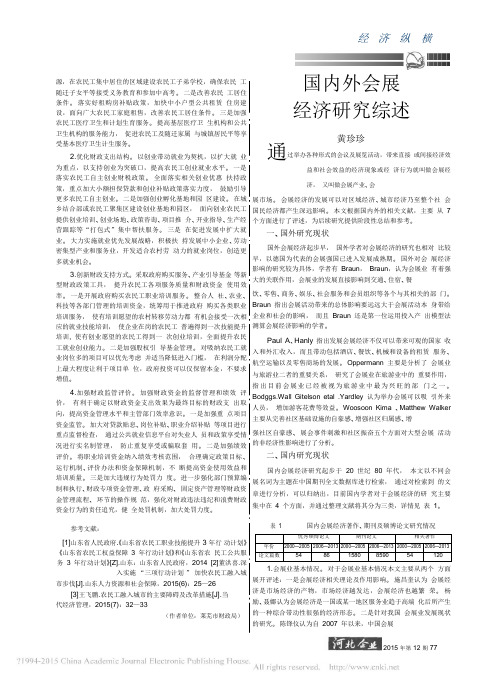
经 济 纵 横源,在农民工集中居住的区域建设农民工子弟学校,确保农民 工随迁子女平等接受义务教育和参加中高考。
二是改善农民 工居住条件。
落实好租购房补贴政策,加快中小户型公共租赁 住房建设,面向广大农民工家庭租售,改善农民工居住条件。
三是加强农民工医疗卫生和计划生育服务。
提高基层医疗卫 生机构和公共卫生机构的服务能力, 促进农民工及随迁家属 与城镇居民平等享受基本医疗卫生计生服务。
2.优化财政支出结构。
以创业带动就业为契机,以扩大就 业为重点,以支持创业为突破口,提高农民工创业就业水平。
一是落实农民工自主创业财税政策。
全面落实相关创业优惠 扶持政策,重点加大小额担保贷款和创业补贴政策落实力度, 鼓励引导更多农民工自主创业。
二是加强创业孵化基地和园 区建设。
在城乡结合部或农民工聚集区建设创业基地和园区, 面向创业农民工提供创业培训、创业场地、政策咨询、项目推 介、开业指导、生产经营跟踪等“打包式”集中帮扶服务。
三是 在促进发展中扩大就业。
大力实施就业优先发展战略,积极扶 持发展中小企业、劳动密集型产业和服务业,开发适合农村劳 动力的就业岗位,创造更多就业机会。
3.创新财政支持方式。
采取政府购买服务、产业引导基金 等新型财政政策工具, 提升农民工各项服务质量和财政资金 使用效率。
一是开展政府购买农民工职业培训服务。
整合人 社、农业、科技等各部门管理的培训资金,统筹用于推进政府 购买各类职业培训服务, 使有培训愿望的农村转移劳动力都 有机会接受一次相应的就业技能培训, 使企业在岗的农民工 普遍得到一次技能提升培训, 使有创业愿望的农民工得到一 次创业培训,全面提升农民工就业创业能力。
二是加强股权引 导基金管理。
对吸纳农民工就业岗位多的项目可以优先考虑 并适当降低进入门槛, 在利润分配上最大程度让利于项目单 位,政府投资可以仅保留本金,不要求增值。
4.加强财政监管评价。
加强财政资金的监督管理和绩效 评价, 有利于确定以财政资金支出效果为最终目标的财政支 出取向,提高资金管理水平和主管部门效率意识。
国内外会展定义及发展状况研究综述

国内外会展定义及开展状况研究综述【摘要】本文通过文献综述的方式,归纳概括了目前国内外学术界对会展旅游的定义、国内外会展旅游开展的现实状况以及提升会展旅游经济的策略研究,并提出我国会展业存在的一些缺乏。
【关键词】会展旅游开展状况提升策略问题会展业作为新兴效劳业,是21世纪的朝阳产业,有着巨大的开展潜力。
会展经济对塑造良好的城市形象和提升城市知名度十分有利,对于城市经济的全面开展更为有利。
为此,我们应注重对会展业的理论研究用以更好地指导实践。
一、会展旅游定义〔一〕国际定义国际上对“会展旅游〞(MICE,Meetings、Incentives、Conventions、Exhibitions)的定义指包括各类专业会议、展览会与博览会、奖励旅游、大型文化体育盛事等活动在内的综合性旅游形式。
Andrew Bradley〔2002〕认为会展旅游是旅游业的一个分支。
〔二〕国内定义关于会展旅游的概念目前国内学术界还远未形成共识。
国内知名的会展专家应丽君认为会展旅游是由于各种类型的会议、博览、展览等活动举办而产生的一种旅游产品。
其他的一些定义主要有:许峰 (2002):会展旅游概念是一个‘舶来品‘大多数学者赞同它对应国外兴旺国家所指的MICE市场。
刘德谦 (2002,2 003):会展旅游就是MICE(会议展览与奖励旅游)中去掉了I(奖励旅游)的MCE 会展旅游是一种实现人际交流的旅游活动,它在目的的追求上和发生要素上都不同于人们熟知的休闲旅游。
王保伦 (2003):会展旅游是为会议和展览活动的举办提供展会场之外的、且与旅游业务相关的效劳并从中获取一定收益的经济活动。
梁留科 (2004):会展是会议、展览等集体性活动的简称会展业是指通过举办各种集会和展览展销会,能够带来明显的经济效益和社会效益的经济现象和行为的产业;会展旅游即MICE是一种通过举办各种会议、博览交易、文化体育、科技交流、奖励旅游等活动而开发的一种旅游工程。
开题+文献综述 长三角会展业发展及盈利模式探讨
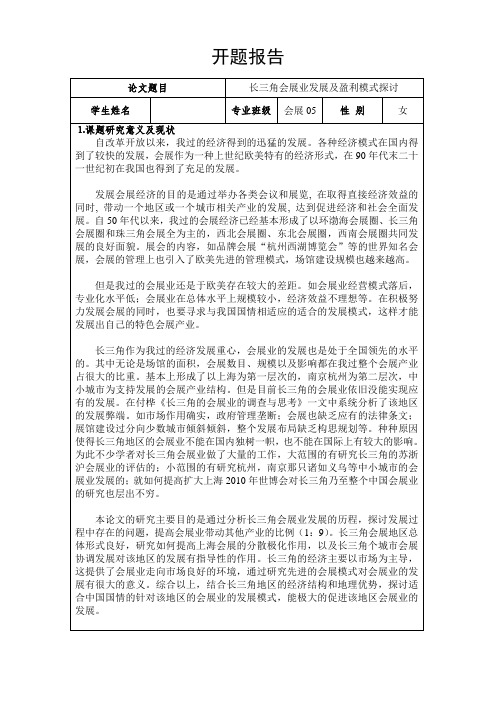
开题报告《长三角会展业发展及盈利模式探讨》文献综述改革开放30年以来,我过的经济得到的迅猛的发展,GDP总量已跃居世界第三位。
一二三产业在国内得到了较快的发展,会展作为一种上世纪欧美特有的经济形式, 90年代末二十一世纪初在我国也得到了充足的发展。
(一)会展的定义及国外发展现状会展是指围绕特定的主题在特定时空大量人群集聚交流的活动。
狭义的会展仅指展览会和会议;广义的会展是会议、展览会和节事活动的统称。
国内外学者对会展的定义不一而足:美国定义会展就是特殊活动,其包涵的范围较广,所以产值大,占的比重也高;而作为全球会展发源地的欧洲认为会展是M&E(meeting&exhibition)或者C&E即把meeting换作convition;中国学者一般把会展定义为 MICE(Meetings;Incentive Tour;Conventions;Events)。
总之,会展的目的是通过举办各类会议和展览, 在取得直接经济效益的同时, 带动一个地区或一个城市相关产业的发展, 达到促进经济和社会全面发展。
会展业成为新的经济增长点是市场经济发展的必然产物,第一个展览会于1850年在英国伦敦诞生。
由此欧洲成为世界会展业的发源地。
经过一百多年的积累发展, 欧洲会展经济整体实力最强、规模最大。
德国、意大利、法国、英国都是世界级的会展业大国。
北美的美国和加拿大是世界会展业的后起之秀,此外还有日本、西亚阿联酋和东南亚的新加坡等。
会展已经在欧美成为一个成熟的产业,主要特点鲜明。
1府对会展业的发展提供必要的支持;2托城市产业培育会展品牌;3过投资、收购、兼并等手段扩张和重组展览资本,形成了展览公司集团化趋势;4会展日趋专业化、国际化,消费类展会呈现旺盛的生命力;5网上展览方兴未艾等。
不难发现以上许多是和国内会展不同的。
比如德国会展政府只做必要的支持,不全程管理。
形成了一批著名的会展公司如如德国汉诺威展览中心等。
会展经济设计文献
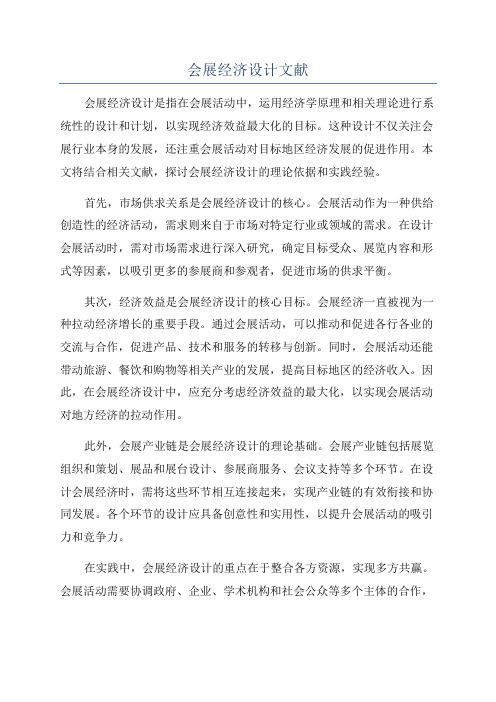
会展经济设计文献会展经济设计是指在会展活动中,运用经济学原理和相关理论进行系统性的设计和计划,以实现经济效益最大化的目标。
这种设计不仅关注会展行业本身的发展,还注重会展活动对目标地区经济发展的促进作用。
本文将结合相关文献,探讨会展经济设计的理论依据和实践经验。
首先,市场供求关系是会展经济设计的核心。
会展活动作为一种供给创造性的经济活动,需求则来自于市场对特定行业或领域的需求。
在设计会展活动时,需对市场需求进行深入研究,确定目标受众、展览内容和形式等因素,以吸引更多的参展商和参观者,促进市场的供求平衡。
其次,经济效益是会展经济设计的核心目标。
会展经济一直被视为一种拉动经济增长的重要手段。
通过会展活动,可以推动和促进各行各业的交流与合作,促进产品、技术和服务的转移与创新。
同时,会展活动还能带动旅游、餐饮和购物等相关产业的发展,提高目标地区的经济收入。
因此,在会展经济设计中,应充分考虑经济效益的最大化,以实现会展活动对地方经济的拉动作用。
此外,会展产业链是会展经济设计的理论基础。
会展产业链包括展览组织和策划、展品和展台设计、参展商服务、会议支持等多个环节。
在设计会展经济时,需将这些环节相互连接起来,实现产业链的有效衔接和协同发展。
各个环节的设计应具备创意性和实用性,以提升会展活动的吸引力和竞争力。
在实践中,会展经济设计的重点在于整合各方资源,实现多方共赢。
会展活动需要协调政府、企业、学术机构和社会公众等多个主体的合作,以确保会展活动的顺利进行。
在设计会展经济时,需考虑到各方的利益和诉求,并充分发挥各方的参与和贡献。
综上所述,会展经济设计在实现经济效益最大化方面起着重要的作用。
通过研究市场供求关系、经济效益和会展产业链等理论,可以为会展经济设计提供理论依据。
同时,在实践中,需注重整合各方资源,实现多方共赢的目标。
希望本文能够对会展经济设计的理论与实践有所启发,并为相关领域的研究提供参考。
关于会展的文献综述
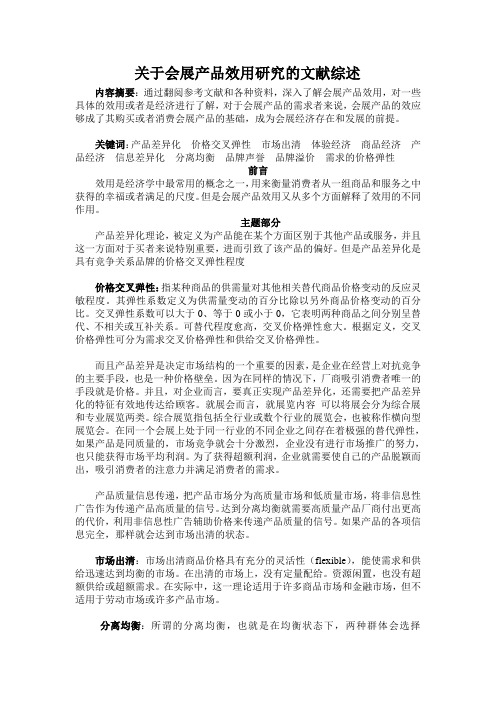
关于会展产品效用研究的文献综述内容摘要:通过翻阅参考文献和各种资料,深入了解会展产品效用,对一些具体的效用或者是经济进行了解,对于会展产品的需求者来说,会展产品的效应够成了其购买或者消费会展产品的基础,成为会展经济存在和发展的前提。
关键词:产品差异化价格交叉弹性市场出清体验经济商品经济产品经济信息差异化分离均衡品牌声誉品牌溢价需求的价格弹性前言效用是经济学中最常用的概念之一,用来衡量消费者从一组商品和服务之中获得的幸福或者满足的尺度。
但是会展产品效用又从多个方面解释了效用的不同作用。
主题部分产品差异化理论,被定义为产品能在某个方面区别于其他产品或服务,并且这一方面对于买者来说特别重要,进而引致了该产品的偏好。
但是产品差异化是具有竞争关系品牌的价格交叉弹性程度价格交叉弹性:指某种商品的供需量对其他相关替代商品价格变动的反应灵敏程度。
其弹性系数定义为供需量变动的百分比除以另外商品价格变动的百分比。
交叉弹性系数可以大于0、等于0或小于0,它表明两种商品之间分别呈替代、不相关或互补关系。
可替代程度愈高,交叉价格弹性愈大。
根据定义,交叉价格弹性可分为需求交叉价格弹性和供给交叉价格弹性。
而且产品差异是决定市场结构的一个重要的因素,是企业在经营上对抗竞争的主要手段,也是一种价格壁垒。
因为在同样的情况下,厂商吸引消费者唯一的手段就是价格。
并且,对企业而言,要真正实现产品差异化,还需要把产品差异化的特征有效地传达给顾客。
就展会而言,就展览内容可以将展会分为综合展和专业展览两类。
综合展览指包括全行业或数个行业的展览会,也被称作横向型展览会。
在同一个会展上处于同一行业的不同企业之间存在着极强的替代弹性,如果产品是同质量的,市场竞争就会十分激烈,企业没有进行市场推广的努力,也只能获得市场平均利润。
为了获得超额利润,企业就需要使自己的产品脱颖而出,吸引消费者的注意力并满足消费者的需求。
产品质量信息传递,把产品市场分为高质量市场和低质量市场,将非信息性广告作为传递产品高质量的信号。
展会经济发展设计参考文献

展会经济发展设计参考文献随着经济全球化的深入,展览会作为一种经济活动方式,在促进经济发展、推动贸易合作以及促进国际交流等方面发挥着越来越重要的作用。
为了更好地发展展会经济,提高展会的效益和影响力,需要进行合理的设计和规划。
本文将参考相关文献,就展会经济发展的设计要点进行探讨。
一、展会经济的概念和特点展会经济是指通过举办展览会来促进经济发展和贸易合作的一种经济模式。
展会经济具有以下特点:首先,展会经济是一种集中展示、交流和合作的平台,能够吸引来自不同地区和行业的参展商和参观者;其次,展会经济具有较高的专业性和针对性,能够满足参展商和参观者的需求;再次,展会经济能够促进产业链的融合和升级,推动经济结构的优化和转型升级。
二、展会经济发展设计的要点1. 定位策略的设计:展会的定位是指明展会的目标、定位和特色,以吸引目标参展商和参观者。
在设计展会的定位策略时,需要充分考虑市场需求、行业特点和竞争对手情况,确定展会的定位,确定展会的主题和特色,以提高展会的吸引力和竞争力。
2. 参展商和参观者的筛选与邀请:展会的成功与否很大程度上取决于参展商和参观者的质量和数量。
因此,在展会经济发展设计中,需要制定参展商和参观者的筛选与邀请策略。
通过对参展商和参观者的需求进行分析,确定合适的参展商和参观者类型,并通过各种渠道进行邀请和推广。
3. 展会场馆和布局设计:展会场馆和布局的设计直接影响展会的效果和体验。
在展会经济发展设计中,需要考虑场馆的大小、设施和交通便利性等因素,确保参展商和参观者的需求得到满足。
同时,还需要合理设计展位的布局和风格,以提高展会的观赏性和参与度。
4. 展会活动和配套服务设计:展会活动和配套服务是展会经济发展的核心内容。
在设计展会活动时,需要充分考虑参展商和参观者的需求和兴趣,确定合适的活动形式和内容,以提高展会的吸引力和参与度。
同时,还需要提供完善的配套服务,如会议场地、餐饮服务、交通接送等,以提升参展商和参观者的体验和满意度。
会展经济与管理毕业论文文献综述

会展经济与管理毕业论文文献综述摘要:会展经济与管理作为一门新兴的学科,已经在全球范围内得到广泛关注和研究。
本文通过对相关文献的综述,旨在分析会展经济与管理领域的研究现状、趋势和发展方向,并探讨其对经济发展和社会影响的重要性。
1. 研究背景会展经济与管理作为一种重要的经济活动,能够促进产业结构升级和经济增长。
近年来,随着会展行业的快速发展,越来越多的研究者开始关注会展经济与管理领域,并对其进行深入研究。
2. 会展经济与管理研究的方法在会展经济与管理研究中,常用的方法包括实证研究、案例分析、统计分析等。
这些方法能够帮助研究者深入分析会展经济与管理领域的现状和问题,并提出相应的解决方案。
3. 会展经济与管理的发展趋势随着社会经济的不断发展,会展经济与管理也面临着新的机遇和挑战。
未来,会展经济与管理领域的发展趋势可能包括数字化、国际化、创新与可持续发展等方面。
4. 会展经济与管理对经济发展的重要影响会展经济与管理在促进经济发展方面发挥着重要作用。
通过举办展览会、会议等活动,可以促进经济交流与合作,提升城市形象,推动相关产业的发展,为当地经济带来巨大的效益。
5. 会展经济与管理对社会影响的重要性会展经济与管理不仅对经济发展具有重要影响,还对社会产生着广泛的影响。
会展活动能够促进文化交流、人才培养、城市建设等方面的发展,为社会进步和文化繁荣做出贡献。
6. 会展经济与管理研究的局限性和展望尽管会展经济与管理研究取得了一定的成果,但仍存在一些局限性和挑战。
未来的研究可以进一步深入探讨会展经济与管理的内在机制、营销策略、创新模式等方面,为会展行业的持续发展提供理论支持和实践指导。
结论:综上所述,会展经济与管理作为一门新兴的学科,不仅在经济发展方面具有重要作用,还对社会产生着广泛影响。
通过深入研究和探讨会展经济与管理领域的研究现状和发展趋势,可以为学术界和业界提供更多有益的见解和决策参考,推动会展经济与管理领域的进一步发展。
会展行业报告文献

会展行业报告文献会展行业是指通过举办展览、展示、会议等方式,为企业和个人提供交流、合作、推广和宣传的平台。
近年来,随着全球经济的发展和国际交流的增加,会展行业得到了迅猛发展。
本文将对会展行业的发展现状、市场规模、发展趋势以及影响因素进行深入分析。
首先,从发展现状来看,会展行业已成为全球经济发展的重要组成部分。
据统计,全球会展市场规模已超过1万亿美元,年均增长率达到10%以上。
各国纷纷加大对会展行业的投入,推动会展业的发展。
在中国,会展行业也呈现出蓬勃发展的态势,成为拉动经济增长的重要力量。
其次,从市场规模来看,会展行业的市场规模不断扩大。
随着全球经济一体化的进程加快,各国之间的交流与合作日益频繁,会展行业的市场需求也在不断增加。
特别是在互联网、人工智能等新技术的推动下,会展行业的市场规模得到了进一步扩大。
再次,从发展趋势来看,会展行业呈现出多元化、专业化、国际化的发展趋势。
随着社会经济的不断发展,人们对会展活动的需求也在不断提升,会展行业的发展呈现出多元化的特点。
同时,会展行业也越来越注重专业化,各类专业展会层出不穷。
另外,国际化是会展行业的重要发展趋势,越来越多的国际展会在全球范围内举办,促进了各国之间的经济交流与合作。
最后,从影响因素来看,会展行业的发展受到多方面因素的影响。
首先是经济因素,全球经济的发展水平直接影响着会展行业的发展。
其次是政策因素,各国政府对会展行业的支持政策也直接影响着会展行业的发展。
再次是技术因素,新技术的不断应用为会展行业的发展提供了新的动力。
最后是市场因素,市场需求的变化也直接影响着会展行业的发展方向。
综上所述,会展行业作为全球经济发展的重要组成部分,市场规模不断扩大,发展趋势多元化、专业化、国际化,受到多方面因素的影响。
未来,随着全球经济的不断发展和国际交流的不断加深,会展行业将迎来更加广阔的发展空间。
会展研究文献综述及外文文献资料
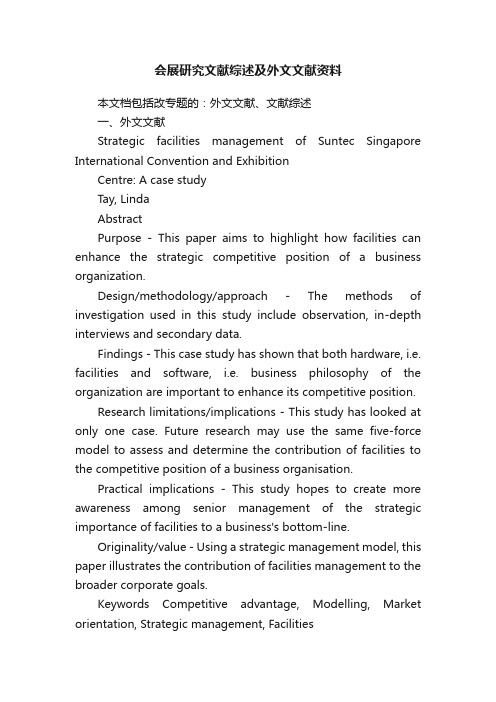
会展研究文献综述及外文文献资料本文档包括改专题的:外文文献、文献综述一、外文文献Strategic facilities management of Suntec Singapore International Convention and ExhibitionCentre: A case studyTay, LindaAbstractPurpose - This paper aims to highlight how facilities can enhance the strategic competitive position of a business organization.Design/methodology/approach - The methods of investigation used in this study include observation, in-depth interviews and secondary data.Findings - This case study has shown that both hardware, i.e. facilities and software, i.e. business philosophy of the organization are important to enhance its competitive position.Research limitations/implications - This study has looked at only one case. Future research may use the same five-force model to assess and determine the contribution of facilities to the competitive position of a business organisation.Practical implications - This study hopes to create more awareness among senior management of the strategic importance of facilities to a business's bottom-line.Originality/value - Using a strategic management model, this paper illustrates the contribution of facilities management to the broader corporate goals.Keywords Competitive advantage, Modelling, Market orientation, Strategic management, FacilitiesIntroductionThe convention and meetings industry is today growing rapidly. While its absolute contribution to a country's national gross domestic product (GDP) may be small, the spillover effect is significant for the tourism sectors such as wholesale and retail trade, hotel and air transport. A study conducted in Singapore showed that for every $1 contributed by this industry, another $12 is generated in the national GDP (International Enterprise Singapore Press Release, 2001). As a result, many destinations around the world have invested in the construction of convention centres (Oppermann, 1996). In particular, the Asia-Pacific region has seen rapidincrease in industry activity since the late 1980s. In its latest projection, the Union of International Associations (UIA) predicts that only Asia will experience a positive 14.9 per cent growth in the next two years (UIA, 2005). The convention and meetings industry is a significant contributor to the Singapore economy. With its strategic geographical location, Singapore has performed consistently well in attracting major conventions (e.g. Asian Aerospace). Singapore was also identified as the top competitor for the Australian convention and meetings industry (Weber and Ladkin, 2003).Studies have shown convention facilities to be an important factor for the success of a convention centre (Hazinski and Detlefsen, 2005; Weber and Ladkin, 2003). Thus far, studies on convention centres have consistently focused on the technical systems of convention facilities Qalayerian, 1996; McMorrow, 1996). There has been a vacuum in studies that links convention facilities with business performance, i.e. the strategic management of facilities. Consequently, the purpose of the casestudy is three-fold. First, it seeks to inform the state of facilities management practices within a convention centre in Singapore. This paves the way for future comparative research on facilities management practices within convention centres; especially those in Asia since this is the fastest growing region for the convention and meetings industry. second, since technology has been a key focus in convention centre research, this case evaluates the sustainability of technology as a competitive advantage. Finally, the case study aims to highlight how facilities can enhance the strategic competitive position of the convention centre business through a strategic management framework, i.e. Porter's five-force model.The case study begins with a literature review of the relationship between facilities and business performance. Key concepts that underpin this case study such as competitive advantage and the five-force model will be introduced here. Next, the case will describe the creation, business philosophy and the facilities of Suntec Singapore International Convention and Exhibition Centre. Following this, the case evaluates whether technology can be a source of competitive advantage for Suntec Singapore and illustrates the role of facilities in enhancing the competitive position of the convention centre. Finally the case study closes with some concluding remarks.Facilities and business performanceThe last three decades have seen the rise of many performance-enhancing theories forbusiness organizations. Whereas these theories have been extensively researched and applied in industries such as hotel, human resource management, marketing, manufacturing, etc. only a handful of studies have been undertaken within thefacilities management industry to examine the link between facilities management and business performance.One notable study was carried out by Alexander (1992) who applied the total quality management (TQM) concept and posited that quality managed facilities will help an organization achieve key objectives. The TQM paradigm emphasizes the use of external-based quality goals, the use of cross-functional teams, widespread employee involvement in the quality improvement process, and the use of process design and control techniques to ensure conformance (Oakland, 1989; Grant et al., 1994). Alexander (1992) concluded his work with a quality plan for facilities management but noted that it will take time for benefits of many of these quality initiatives to emerge, although there may be short-term improvements. Tranfield and Akhlaghi (1995) related facilities to business performance indicators through a strategic capabilities approach. According to the authors, this approach focuses on the design of routines (co-ordination through systems, procedures and structures) for long-term, continuing performance improvement. The authors argued for the relevance of key integration indicators such as the degree of teamwork, standardization of inputs and cultural reinforcements for improving facilities management performance.A closely related concept to strategic capabilities is the idea of competitive advantage. Just as strategic capabilities focuses on developing internal capabilities of the firm, competitive advantage extends the concept by looking at internal capabilities that will produce a sustainable positional advantage, i.e. superior customer value and/or lowest delivered cost. There are two basic sources of competitive advantage: superior skills and resources. Barney (1991) lists four essential requirements for a resource/skillto be a source of sustainable competitive advantage:(1) it must be valuable;(2) it must be rare among a firm's current and potential competitors;(3) it must be imperfectly imitable; and(4) there must not be any strategically equivalent substitutes for this resource/skill.In line with this perspective, there have been many attempts to empirically derive "generic" competitive strategies (Miller, 1986; Kim and Lim, 1988). Many of these conceptualizations have been influenced by the work of Porter who first published a book on Competitive Strategy (1980) followed by Competitive Advantage (1985). Porter asserted that in order to derive a competitive strategy, the organization must first evaluate its position within the industry against five factors: power over buyers, power over suppliers, barriers to entry in the industry, the threat of substitute products, and the overall level of rivalry within the industry. Figure 1 diagrammatically portrays Porters' five-force model.While there has been many performance-enhancing models developed over the years, the five-force model has received strong support from within the property and facilities industry as a strategic management framework in understanding the role of facilities in business performance. O'Mara (1999) suggested that a thorough understanding of a firm's competitive strategy is required before determining the best property and facility strategies. This understanding begins with a clear diagnosis of the forces of competition within the industry. From here, it is clear that the five-force model complements the other strategic management concepts such as TQM and strategic capabilities inthat it provides an assessment of the external environment in order that a competitive strategy may be developed through the firm's internal capabilities. Similarly, Edwards and Ellison (2004) considered Porter's model to be sufficiently well developed and flexible to be capable of broad application across a range of different business types. This allows the properly and facility implications to be explored over a range of different strategies applied to different organisations. The cogency of the five-force model is thus well-positioned for this study.The next section provides the background information to Suntec City by describing its creation, business philosophy and facilities. This then serves as a backdrop against which the role of facilities in enhancing the business performance of Suntec Singapore International Convention and Exhibition Centre will be evaluated.The creation of Suntec CityLocated on 11.7-hectare of prime land adjacent to the Central Business District in Singapore, Suntec City is the single largest integrated commercial development with five office towers, a shopping mall, and an international convention and exhibition centre (Suntec Singapore) with a total of 7 million square feet of space. Suntec City Development Pte Ltd was formed by 11 Hong Kong tycoons in 1988 through a winning bid of S$209 million for the land. By 1997, Suntec City was completed and today offers direct access to 5,200 hotel rooms, 1,000 retail stores, 300restaurants and the region's new centre for the performing arts, Esplanade - Theatres on the Bay. The business philosophy In the early days, Suntec City was called a bowling alley by the press because of the lack of visitors. Many attribute this topoor location as Suntec City was not near enough to prime office and shopping locations. In response, Suntec City defined a niche for itself as Asia's Vertical Silicon Valley by embracing technology and today has an occupancy rate of more than 95 per cent for its office and retail properties.According to its CEO, Mr Wong Ah Long, a critical success factor for Suntec City is an open style of management that views criticisms as a source for improvements and swiftly responding to them. At the same time, Suntec also adopts a business concept termed facilities service provider (FSP). The FSP concept transforms the traditional role of a landlord to that of a business partner with its tenants through strategic partnership, business alliance and constructive connectivity. Under this broad FSP concept, many IT initiatives have been implemented. These include: * broad band access via fibre optic cable to enable internet communication among tenants;* incubators for start-up companies which comprise shared office space, management and administrative services, and access to capital via a network of investors and a virtual set-up for companies that do not need physical space;* a community web portal, with intranet capabilities, to enable tenants to shop, sell, acquire goods and services, book restaurants and/or travel reservations; etc.* common telecommunications connection that enables tenants to communicate with each other at no cost, thereby encouraging networking among tenants; and* an internet call center enables tenants to provide online customer support for their web sites to build relationships with their customer and boost online sales.Suntec Singapore International Convention and ExhibitionCentre (SSICEC)One of the key facilities of Suntec City is its convention and exhibition centre - Suntec Singapore. It has total gross area 100,00Om2 and is one of Asia-Pacific's largest purpose-built venues. The six-storey centre was built at a cost of S$620 million. Since its opening, Suntec Singapore has won many awards with its standards of service, security and facilities and has hosted 1,356 and 1,288 events for the years 2001 and 2002, respectively. Suntec Singapore's vision is to be "The World's Best Host" and it prides itself in its ability in customizing facilities tocater to their customers' needs. They have the ability to organize a meeting of ten or a convention of 10,000 people.The facilities available at Suntec Singapore include:* Car parking. Suntec City has the largest carpark in Singapore with 3,200 parking lots spread over two basements. Music and landscaping is also present in the carpark to provide the Suntec City user maximum comfort from the very beginning to the end. In addition, there are trained traffic wardens in the car park to direct cars to empty parking lots.* Convention hall. This is the largest column-free meeting area in Asia capable of accommodating 12,000 delegates in its 12,000m^sup 2^ column free space.* Exhibition hall. Its 12,000m^sup 2^ floor space can be subdivided into three smaller areas if required.* Ballroom. The 2,150 m^sup 2^ ballroom is a multi-purpose, sub-dividable space that is able to accommodate 1,800 people theatre style featuring pre-function areas.* Meeting rooms. There are 31 meeting rooms, ranging from 76 to 253m^sup 2^, having the capacity to fit in 10-400 people. All these rooms are equipped with state-of-the-art technology tocater to clients' needs. There is also a special VIP meeting room for up to 26 delegates, in the Executive Suite, which has its own lounge and bar area.* Theatre. The theatre spans over two levels and has a 596 seating capacity.* Concourse. A multi-purpose space on level 3 with 930 m^sup 2^ of space, the concourse can cater for up to 600 persons in banquet-style.* Lobby. Another multi-purpose space at the entrance to Suntec Singapore, the lobby is mainly used for exhibitions and public displays.* Gallery. The gallery is 3,700m^sup 2^ of versatile space located that can cater for 1,000 delegates in a banquet-style setting or 3,000 delegates in a theatre-style setting.To complement the above facilities, Suntec Singapore also provides services such as food and beverage and it also has the largest banquet kitchen in Singapore, providing on-site and off-site catering facilities for all events. The Digital Congress Network system provides infra-red simultaneous interpretation for up to 14 languages. The employment of this infra-red light instead of radio waves better ensures that sound signals do not leak into adjoining halls. In addition, the portable seating system allows flexible configuration and allows for easy set-up and retrieval. In addition, Suntec Singapore has also formed an alliance with its neighbours. This creates a self-contained and totally integrated destination. The alliance includes hotel partners offering attractive rates for convention delegates, shopping malls in the vicinity, and the Esplanade - Theatres on the Bay.Challenges for Suntec Singapore international exhibition and convention centreThe convention and exhibition industry which includes meetings, incentives, conventions and exhibitions (MICE) is worth about a billion dollars a year and provides 15,000 jobs in Singapore (International Enterprise Singapore Press Release, 2001). While Singapore has performed well as a MICE destination, the industry is getting increasingly competitive. Table I shows that there are several countries which have shown a growth greater than 50 per cent in the last ten years since 1993. Table II shows the top ten international meeting cities in 2004.Further, Malaysia's Putra World Trade Centre has been playing a more active role to promote the country as a convention and exhibition destination since it came under a new management in 1993. The authorities are also working on improving the air access of destinations like Penang, Sabah and Sarawak from their key overseas markets. Equipped with strong economic performance, good infrastructure, affordable hotel rates, support from the federal government, state governments and airlines, the future of Malaysia's convention industry remains bright. Thailand's newly completed International Trade and Exhibition Centre is also a worthy competitor to note as the country enjoyed a 69 per cent growth in its convention industry from 1993 to 2002. On the local front, The Singapore Expo, located five minutes' drive from the airport and served by the Expo MRT Station is one of the most recent and largest exhibition centres in the region. Since first opening its doors on 4 March 1999, Singapore Expo has hosted more than 218 theme shows and received over 5.7 million visitors. It has 60,000m^sup 2^ (645,000 square feet) of indoor, column-free exhibition space, another 25,000 m^sup 2^ (270,000 square feet) of outdoor exhibition space and 19 conference halls and meeting rooms.Furthermore, the centre is technologically advanced and equipped with - the latest state-of-the-art presentation, interpretation, sound and lighting systems, and connectivity. Designed by world-renowned and award-winning architect, Cox Richardson Rayner, the 25 hectare Singapore Expo was built at a cost of over $220 million.Is technology the source of Suntec City's competitive advantage?According to Day and Wensley (1988), competitive advantage can be defined as superior skills or resources that a business deploys to set up barriers that make imitation difficult. The provision of superior customer value or the achievement of lower relative costs result in better performance such as increased market share and/or profitability. The concept of competitive advantage is central to business strategising because the very purpose of strategy is about seeking new edges in a market while slowing the erosion of present advantages. In general, there are two broad sources of competitive advantage:(1) superior skills; and(2) superior resources.However, superior skills and resources are not automatically converted into positional advantages nor is there a certain performance payoff from superior cost or differentiated position. Both conversions are mediated jointly by strategic choices including objectives and entry timing and the quality of tactics and implementation.Superior skills arise from the ability to perform individual functions more effectively than other firms. For example, superior engineering or technical skills may lead to greater precision or reliability in the finished product. Other skills may be those thatare derived from the systems and organisation structure that enables a firm to adapt more responsively and faster to changes in market requirements. As a FSP and landlord, Suntec City's finished product in this case is space that meets the need of its users. To understand the needs of users requires first and foremost, reliable intelligence generation, effective intelligence dissemination and swift responsiveness. This equates to the business concept of being market oriented. In Suntec's case, an open style of management and regular dialogues with its tenants and other users serves to collect the important information about user needs. A flat organisation structure ensures that the information gathered is disseminated effectively down the supply chain. The FSP concept provides the cornerstone for Suntec to become a market oriented business organisation. The initiatives under the FSP programme are designed to help tenants run their businesses more efficiently and effectively. For example, Suntec looks into the needs of smaller start-up companies by providing incubators and related administrative services and thus lowering the capital cost of these businesses one of their primary concerns. By doing so, tenants are satisfied and this translates into high occupancy rates.Superior resources are more tangible requirements for advantage that enable a firm to exercise its capabilities. They may reside in the scale of the manufacturing facility, the location, the breadth of sales force and distribution coverage, the availability of automated assembly lines, or the family brand name. When Suntec first opened its doors, its location was considered its Achilles' heel. Several factors were important in turning its location into a superior resource. First, it is the use of technology to condense time and space. For example, the broadband accessallows efficient internet communication among tenants. Today, the connectivity provided by information technology has become a source of differentiation for Suntec whose mission is to be Asia's Silicon Valley. Second, Suntec "created" its own locational advantage by forming an alliance with its neighbours. There is synergy in the alliance as the neighbouring uses (e.g. hotel, entertainment) complement Suntec City. In addition, there is also the benefit of agglomeration economies by forming an alliance with the neighbouring competing uses. Together, it creates a self-contained and totally integrated destination.Central to the concept of competitive advantage is the setting up of barriers that make imitation difficult. To this end, if we look at Suntec's differentiated position through the use of technology, it is a barrier that is relatively easy to imitate if the financial means are available to its competitors. This is likely so since the other players in the market are also big players with strong financial backing such as Singapore Expo and Malaysia's Putra World Trade Centre. The positional advantage of Suntec in providing superior customer value, instead, lies in Suntec's holistic approach to business management. First, the strong management support given by Suntec's top management to create a vibrant and modern development that is in tune with Singapore's progress as a nation is a key driver for its Suntec's positional advantage. Second, it is the strategic choices made by Suntec's management in adopting a market oriented approach through the FSP programme and maintaining a good long-term relationship with its stakeholders through alliances. And finally, Suntec's commitment in meeting the needs of its users through the implementation of the FSP initiative is the closing link to Suntec's competitive advantage.In summary, while financial limitations can raise the barrier for imitation of hardware such as technology and thus provide some degree of competitive advantage, it is the whole package of software such as management support and commitment, business management talent and skills that are more difficult to replicate and thus provide a more sustainable competitive advantage.Facilities and Suntec Singapore's competitive positionThe five-force model developed by Porter determines industry profitability through the understanding of a subject company's competitive position in relation to five forces, namely, suppliers potential new entrants, competitors, buyers and threat of substitute products or services. The model allows the illustration of how forces within an industry can either function to help firms sustain high profits, or how the same forces can provide imposing barriers to profitability.The following discussion examines the impact of each force on Suntec Singapore's competitive position and how facilities and its related services can enhance its competitive position.Potential entrantsThe seriousness of the threat of entry depends on the barriers present. Essentially the sources of barrier include cost advantages, product differentiation and capital requirements. In the convention centre business, the most effective barrier lies in product differentiation. And in the case of facilities, the location of Suntec Singapore can be utilised to market it as the gateway to Asia. Singapore has the advantage of being in a geographically strategic position. In addition, the security, the effective transportation network, state-of-the-art facilities and proximity to neighbouring Malaysia and Thailand for extended holiday is awhole locational advantage that diminishes the threat of potential entry. In a study by Dube and Renaghan (1999) on the lodging industry's best practices, the authors noted that a hotel's location is a structural quality that is tremendous source of sustainable competitive advantage. Convenient location remains the primary hotel attribute driving purchase decision.SuppliersSuppliers can exert bargaining power on participants in an industry by raising prices and reducing the quality of purchased goods and services. Powerful suppliers can thereby squeeze profitability out of an industry unable to recover cost increases in its own prices. A supplier is powerful if it is dominated by a few companies, the product is unique and if the industry is not an important customer of the supplier group.Suntec Singapore depends to a large extent on outsourced service providers to meet the needs of their clients. To ensure a ready supply of services, Suntec Singapore recruits worldwide for these services and talents. In addition, because Suntec Singapore is a big client and offers a bigcontract, there are many willing suppliers to offer services such as broadband access, maintenance, etc. Further, suppliers of services such as cleaning and building maintenance belong to highly competitive industries and as such they have a weaker bargaining position against Suntec Singapore.CompetitorsThe competitive position of a firm is weakened if competitors are numerous or are roughly equal in size and power. The competition Suntec Singapore faces can be analyzed at two levels. The first level relates to the appeal of the country destination as a whole, while the second level is concentrated onthe convention centres within Singapore.At the international level, the competitors are many and are competitive in terms of size and power. However, from Table D, it appears that Singapore is doing well coming in 5th as the top ten international meeting cities. It is also worthy to note that Singapore is the only Asian city to make it into the top ten. However, Australia, South Korea and Thailand are increasingly popular given the results of growth rates in Table I.On the local front, Suntec Singapore is still a preferred venue due to its easy accessibility to various other entertainment outlets and hotels. The positive image that is associated with the Suntec brand name also proved the success of its marketing and branding initiatives through the years. To remain ahead of competition, Suntec Singapore has to ensure that its physical facilities are consistent with its branding as Asia's Vertical Silicon Valley, i.e. it is state-of-the-art and that meets the needs of the MICE industry. Dube and Renaghan (1999) observed that for the top hotels, the physical product is closely tied to fulfilling either functional or aesthetic brand promises.Although the neighbouring hotels can also be considered to be Suntec Singapore's competitors for local banquet events, their co-location within the Marina area generate agglomeration economies by creating a total experience for its visitors. In addition, the scale of the Suntec City Development including its office and retail blocks sends a strong signal to Suntec Singapore's competitors on its financial and management capabilities to retaliate when its market position is threatened.BuyersA buyer group is powerful if it purchases in large volumes and if the products it purchases are standard or undifferentiated.。
文献综述--中小零售业经营者对大型会展活动的影响的感知研究
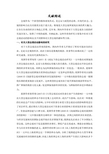
文献综述会展作为一个新型的服务表现形式,是会议与展览的总称。
在现代社会,会展的影响力以及关联度正趋于最大化,特别是大型会展所展现出来的莫大魅力,让各行各业的经济主体趋之若鹜。
近年来,国内外学者对于大型会展各方面的研究逐步深入,取得了丰硕的成果。
归纳起来,这些学者的研究主要集中在对大型会展活动的影响以及不同群体对大型会展的感知等方面。
一、有关大型会展活动影响的研究对于大型会展活动带来的影响,国内外学者几乎探讨了所有可能涉及的行业,无论从宏观的经济、政治方面还是微观的旅游、饮食等行业都出现了一定的研究成果。
比较有代表性的如下:美国学者莫布斯(2005)在《政坛下的会展活动研究》一文中指出对国家的大型会展活动来讲,总是与各国政坛有极大的关系的,大型会展活动不但会给各国的经济带来发展,同样会为这些国家的政坛带来一次促进,一般来讲,能够举行大型会展活动的国家在世界政坛的地位一定是举足轻重的。
英国学者埃尔波特(2008)在《旅游型会展对国家经济发展的影响》一文中指出旅游型的会展一般围绕各国的重要旅游文化展开,这种类型的会展有助于提升国家的旅游管理水平、推广国家的旅游文化元素,促进国家旅游经济的发展,为国家的经济进步增添活力。
我国学者郭哲荣(2007)在《大型会展活动对饮食行业产生的影响》一文中指出大型会展活动的举办不但在宏观上会对经济、政治产生影响,而且对一些微观的行业也会产生较大的影响,文中针对饮食行业受大型会展活动的影响程度进行了实证研究,最后得出大型会展活动对于饮食行业的影响主要表现在饮食文化推广、饮食品牌创建与口碑方面。
我国学者李峰(2008)在《浅谈国际会展对我国经济的影响》一文中指出随着全球经济一体化的提速,多国之间的经济往来更甚,与经济发展相关的国际会展开始在很多国家开展,我国也先后承办了不少国际大型会展,这些会展对于促进我国经济增长,降低产品交易成本,增强企业国际竞争力具有非常积极的意义。
我国学者杜辉(2011)在《从上海世博会看节事经济效应》一文中以上海世博会这一节事的举办为例,分析了我国通过举办大型节事来发展城市经济的路径选择,并就上海世博会对上海经济所产生的巨大影响从多个方面进行了分析。
重庆会展产业发展战略研究文献综述
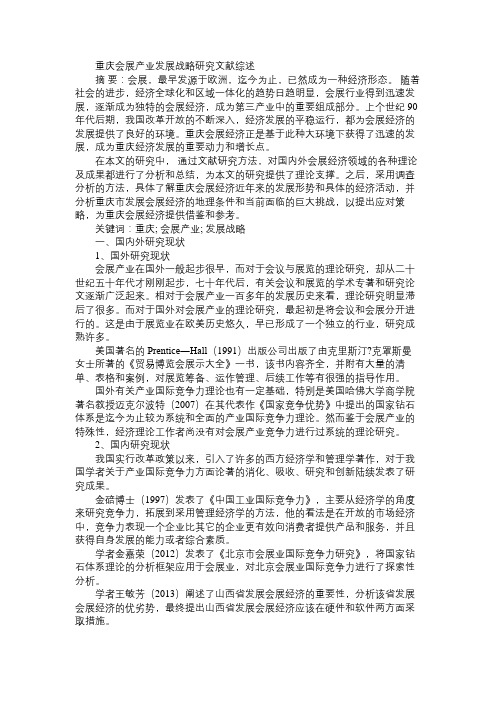
重庆会展产业发展战略研究文献综述摘要:会展,最早发源于欧洲,迄今为止,已然成为一种经济形态。
随着社会的进步,经济全球化和区域一体化的趋势日趋明显,会展行业得到迅速发展,逐渐成为独特的会展经济,成为第三产业中的重要组成部分。
上个世纪90年代后期,我国改革开放的不断深入,经济发展的平稳运行,都为会展经济的发展提供了良好的环境。
重庆会展经济正是基于此种大环境下获得了迅速的发展,成为重庆经济发展的重要动力和增长点。
在本文的研究中,通过文献研究方法,对国内外会展经济领域的各种理论及成果都进行了分析和总结,为本文的研究提供了理论支撑。
之后,采用调查分析的方法,具体了解重庆会展经济近年来的发展形势和具体的经济活动,并分析重庆市发展会展经济的地理条件和当前面临的巨大挑战,以提出应对策略,为重庆会展经济提供借鉴和参考。
关键词:重庆; 会展产业; 发展战略一、国内外研究现状1、国外研究现状会展产业在国外一般起步很早,而对于会议与展览的理论研究,却从二十世纪五十年代才刚刚起步,七十年代后,有关会议和展览的学术专著和研究论文逐渐广泛起来。
相对于会展产业一百多年的发展历史来看,理论研究明显滞后了很多。
而对于国外对会展产业的理论研究,最起初是将会议和会展分开进行的。
这是由于展览业在欧美历史悠久,早已形成了一个独立的行业,研究成熟许多。
美国著名的Prentice―Hall(1991)出版公司出版了由克里斯汀?克罩斯曼女士所著的《贸易博览会展示大全》一书,该书内容齐全,并附有大量的清单、表格和案例,对展览筹备、运作管理、后续工作等有很强的指导作用。
国外有关产业国际竞争力理论也有一定基础,特别是美国哈佛大学商学院著名教授迈克尔波特(2007)在其代表作《国家竞争优势》中提出的国家钻石体系是迄今为止较为系统和全面的产业国际竞争力理论。
然而鉴于会展产业的特殊性,经济理论工作者尚没有对会展产业竞争力进行过系统的理论研究。
2、国内研究现状我国实行改革政策以来,引入了许多的西方经济学和管理学著作,对于我国学者关于产业国际竞争力方面论著的消化、吸收、研究和创新陆续发表了研究成果。
国外会展问题研究综述
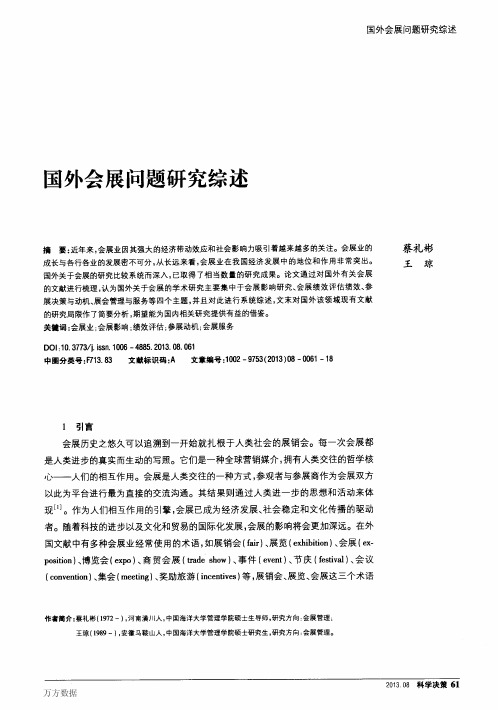
步发展和更深层次研究提供参考和借鉴。 2会展的经济影响和社会影响 2.1会展的经济影响 会展业在区域经济以及城市发展过程中具有较强的推动作用,被誉为地方经济发 展的“助推器”。会展业的产业关联带动效应较强,一个区域会展业的繁荣可盘活该 区域交通、通讯、金融及其他特色产业,并且能够推动区域产业结构升级。成功的展会 使城市形象与竞争力得到提升,从而吸引更多投资机会。会展业发展水平已成为现代 社会经济发达程度的衡量标准之一。外国文献中,针对会展经济影响的评估主要从四
“成本效益分析”等经ቤተ መጻሕፍቲ ባይዱ评量方式来估计庆典活动的经济效益。游客花费的量测通常
是观光经济影响评估的基础,原因是游客的花费是观光发展带给地方财富的来源。除 了游客消费外,经济效果的估量通常是通过估计举办活动所产生的最终需求变动,在 地区经济中经过多次循环所产生的综合(直接、间接以及诱发)效果。而乘数效应 (multiplier)通常被用以讨论整体经济效果的指标。经济乘数效应的估算可以透过投
商场的发展¨4|。
也有学者指出,如果没有采用结构严谨的研究方法,大型事件的经济影响的水平 很容易被高估[1 5|。如前所述,多数学者运用投入.产出模式于会展经济影响评估,在 此过程中,如果没有考虑产业问的互动关系,会展对举办地经济的负面作用就容易被 忽略,从而会展对举办地生产总值和就业的影响会被夸大【1 6|。通过举办此类事件,主
个主题着手,如表1。
表1
研究方向 会展吸引外来人员,增加游客花费等效益 外来、本地游客在会展活动中的花费对当地经济的影响 会展经济效益的空间分布 会展活动对消费结构和产业活动的影响
会展经济影响评估研究方向及代表
研究者
Bodggs&Wall[2];Gitelson Hatt∞[5]
会展研究文献综述及外文文献资料
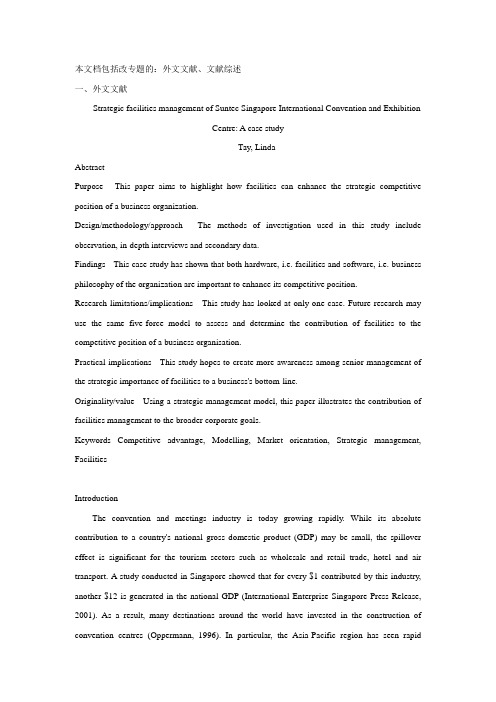
本文档包括改专题的:外文文献、文献综述一、外文文献Strategic facilities management of Suntec Singapore International Convention and ExhibitionCentre: A case studyTay, LindaAbstractPurpose - This paper aims to highlight how facilities can enhance the strategic competitive position of a business organization.Design/methodology/approach - The methods of investigation used in this study include observation, in-depth interviews and secondary data.Findings - This case study has shown that both hardware, i.e. facilities and software, i.e. business philosophy of the organization are important to enhance its competitive position.Research limitations/implications - This study has looked at only one case. Future research may use the same five-force model to assess and determine the contribution of facilities to the competitive position of a business organisation.Practical implications - This study hopes to create more awareness among senior management of the strategic importance of facilities to a business's bottom-line.Originality/value - Using a strategic management model, this paper illustrates the contribution of facilities management to the broader corporate goals.Keywords Competitive advantage, Modelling, Market orientation, Strategic management, FacilitiesIntroductionThe convention and meetings industry is today growing rapidly. While its absolute contribution to a country's national gross domestic product (GDP) may be small, the spillover effect is significant for the tourism sectors such as wholesale and retail trade, hotel and air transport. A study conducted in Singapore showed that for every $1 contributed by this industry, another $12 is generated in the national GDP (International Enterprise Singapore Press Release, 2001). As a result, many destinations around the world have invested in the construction of convention centres (Oppermann, 1996). In particular, the Asia-Pacific region has seen rapidincrease in industry activity since the late 1980s. In its latest projection, the Union of International Associations (UIA) predicts that only Asia will experience a positive 14.9 per cent growth in the next two years (UIA, 2005). The convention and meetings industry is a significant contributor to the Singapore economy. With its strategic geographical location, Singapore has performed consistently well in attracting major conventions (e.g. Asian Aerospace). Singapore was also identified as the top competitor for the Australian convention and meetings industry (Weber and Ladkin, 2003).Studies have shown convention facilities to be an important factor for the success of a convention centre (Hazinski and Detlefsen, 2005; Weber and Ladkin, 2003). Thus far, studies on convention centres have consistently focused on the technical systems of convention facilities Qalayerian, 1996; McMorrow, 1996). There has been a vacuum in studies that links convention facilities with business performance, i.e. the strategic management of facilities. Consequently, the purpose of the case study is three-fold. First, it seeks to inform the state of facilities management practices within a convention centre in Singapore. This paves the way for future comparative research on facilities management practices within convention centres; especially those in Asia since this is the fastest growing region for the convention and meetings industry. second, since technology has been a key focus in convention centre research, this case evaluates the sustainability of technology as a competitive advantage. Finally, the case study aims to highlight how facilities can enhance the strategic competitive position of the convention centre business through a strategic management framework, i.e. Porter's five-force model.The case study begins with a literature review of the relationship between facilities and business performance. Key concepts that underpin this case study such as competitive advantage and the five-force model will be introduced here. Next, the case will describe the creation, business philosophy and the facilities of Suntec Singapore International Convention and Exhibition Centre. Following this, the case evaluates whether technology can be a source of competitive advantage for Suntec Singapore and illustrates the role of facilities in enhancing the competitive position of the convention centre. Finally the case study closes with some concluding remarks.Facilities and business performanceThe last three decades have seen the rise of many performance-enhancing theories forbusiness organizations. Whereas these theories have been extensively researched and applied in industries such as hotel, human resource management, marketing, manufacturing, etc. only a handful of studies have been undertaken within the facilities management industry to examine the link between facilities management and business performance.One notable study was carried out by Alexander (1992) who applied the total quality management (TQM) concept and posited that quality managed facilities will help an organization achieve key objectives. The TQM paradigm emphasizes the use of external-based quality goals, the use of cross-functional teams, widespread employee involvement in the quality improvement process, and the use of process design and control techniques to ensure conformance (Oakland, 1989; Grant et al., 1994). Alexander (1992) concluded his work with a quality plan for facilities management but noted that it will take time for benefits of many of these quality initiatives to emerge, although there may be short-term improvements. Tranfield and Akhlaghi (1995) related facilities to business performance indicators through a strategic capabilities approach. According to the authors, this approach focuses on the design of routines (co-ordination through systems, procedures and structures) for long-term, continuing performance improvement. The authors argued for the relevance of key integration indicators such as the degree of teamwork, standardization of inputs and cultural reinforcements for improving facilities management performance.A closely related concept to strategic capabilities is the idea of competitive advantage. Just as strategic capabilities focuses on developing internal capabilities of the firm, competitive advantage extends the concept by looking at internal capabilities that will produce a sustainable positional advantage, i.e. superior customer value and/or lowest delivered cost. There are two basic sources of competitive advantage: superior skills and resources. Barney (1991) lists four essential requirements for a resource/skill to be a source of sustainable competitive advantage:(1) it must be valuable;(2) it must be rare among a firm's current and potential competitors;(3) it must be imperfectly imitable; and(4) there must not be any strategically equivalent substitutes for this resource/skill.In line with this perspective, there have been many attempts to empirically derive "generic" competitive strategies (Miller, 1986; Kim and Lim, 1988). Many of these conceptualizations havebeen influenced by the work of Porter who first published a book on Competitive Strategy (1980) followed by Competitive Advantage (1985). Porter asserted that in order to derive a competitive strategy, the organization must first evaluate its position within the industry against five factors: power over buyers, power over suppliers, barriers to entry in the industry, the threat of substitute products, and the overall level of rivalry within the industry. Figure 1 diagrammatically portrays Porters' five-force model.While there has been many performance-enhancing models developed over the years, the five-force model has received strong support from within the property and facilities industry as a strategic management framework in understanding the role of facilities in business performance. O'Mara (1999) suggested that a thorough understanding of a firm's competitive strategy is required before determining the best property and facility strategies. This understanding begins with a clear diagnosis of the forces of competition within the industry. From here, it is clear that the five-force model complements the other strategic management concepts such as TQM and strategic capabilities in that it provides an assessment of the external environment in order that a competitive strategy may be developed through the firm's internal capabilities. Similarly, Edwards and Ellison (2004) considered Porter's model to be sufficiently well developed and flexible to be capable of broad application across a range of different business types. This allows the properly and facility implications to be explored over a range of different strategies applied to different organisations. The cogency of the five-force model is thus well-positioned for this study.The next section provides the background information to Suntec City by describing its creation, business philosophy and facilities. This then serves as a backdrop against which the role of facilities in enhancing the business performance of Suntec Singapore International Convention and Exhibition Centre will be evaluated.The creation of Suntec CityLocated on 11.7-hectare of prime land adjacent to the Central Business District in Singapore, Suntec City is the single largest integrated commercial development with five office towers, a shopping mall, and an international convention and exhibition centre (Suntec Singapore) with a total of 7 million square feet of space. Suntec City Development Pte Ltd was formed by 11 Hong Kong tycoons in 1988 through a winning bid of S$209 million for the land. By 1997, Suntec City was completed and today offers direct access to 5,200 hotel rooms, 1,000 retail stores, 300restaurants and the region's new centre for the performing arts, Esplanade - Theatres on the Bay. The business philosophyIn the early days, Suntec City was called a bowling alley by the press because of the lack of visitors. Many attribute this to poor location as Suntec City was not near enough to prime office and shopping locations. In response, Suntec City defined a niche for itself as Asia's Vertical Silicon Valley by embracing technology and today has an occupancy rate of more than 95 per cent for its office and retail properties.According to its CEO, Mr Wong Ah Long, a critical success factor for Suntec City is an open style of management that views criticisms as a source for improvements and swiftly responding to them. At the same time, Suntec also adopts a business concept termed facilities service provider (FSP). The FSP concept transforms the traditional role of a landlord to that of a business partner with its tenants through strategic partnership, business alliance and constructive connectivity. Under this broad FSP concept, many IT initiatives have been implemented. These include: * broad band access via fibre optic cable to enable internet communication among tenants;* incubators for start-up companies which comprise shared office space, management and administrative services, and access to capital via a network of investors and a virtual set-up for companies that do not need physical space;* a community web portal, with intranet capabilities, to enable tenants to shop, sell, acquire goods and services, book restaurants and/or travel reservations; etc.* common telecommunications connection that enables tenants to communicate with each other at no cost, thereby encouraging networking among tenants; and* an internet call center enables tenants to provide online customer support for their web sites to build relationships with their customer and boost online sales.Suntec Singapore International Convention and Exhibition Centre (SSICEC)One of the key facilities of Suntec City is its convention and exhibition centre - Suntec Singapore. It has total gross area 100,00Om2 and is one of Asia-Pacific's largest purpose-built venues. The six-storey centre was built at a cost of S$620 million. Since its opening, Suntec Singapore has won many awards with its standards of service, security and facilities and has hosted 1,356 and 1,288 events for the years 2001 and 2002, respectively. Suntec Singapore's vision is to be "The World's Best Host" and it prides itself in its ability in customizing facilities tocater to their customers' needs. They have the ability to organize a meeting of ten or a convention of 10,000 people.The facilities available at Suntec Singapore include:* Car parking. Suntec City has the largest carpark in Singapore with 3,200 parking lots spread over two basements. Music and landscaping is also present in the carpark to provide the Suntec City user maximum comfort from the very beginning to the end. In addition, there are trained traffic wardens in the car park to direct cars to empty parking lots.* Convention hall. This is the largest column-free meeting area in Asia capable of accommodating 12,000 delegates in its 12,000m^sup 2^ column free space.* Exhibition hall. Its 12,000m^sup 2^ floor space can be subdivided into three smaller areas if required.* Ballroom. The 2,150 m^sup 2^ ballroom is a multi-purpose, sub-dividable space that is able to accommodate 1,800 people theatre style featuring pre-function areas.* Meeting rooms. There are 31 meeting rooms, ranging from 76 to 253m^sup 2^, having the capacity to fit in 10-400 people. All these rooms are equipped with state-of-the-art technology to cater to clients' needs. There is also a special VIP meeting room for up to 26 delegates, in the Executive Suite, which has its own lounge and bar area.* Theatre. The theatre spans over two levels and has a 596 seating capacity.* Concourse. A multi-purpose space on level 3 with 930 m^sup 2^ of space, the concourse can cater for up to 600 persons in banquet-style.* Lobby. Another multi-purpose space at the entrance to Suntec Singapore, the lobby is mainly used for exhibitions and public displays.* Gallery. The gallery is 3,700m^sup 2^ of versatile space located that can cater for 1,000 delegates in a banquet-style setting or 3,000 delegates in a theatre-style setting.To complement the above facilities, Suntec Singapore also provides services such as food and beverage and it also has the largest banquet kitchen in Singapore, providing on-site and off-site catering facilities for all events. The Digital Congress Network system provides infra-red simultaneous interpretation for up to 14 languages. The employment of this infra-red light instead of radio waves better ensures that sound signals do not leak into adjoining halls. In addition, the portable seating system allows flexible configuration and allows for easy set-up and retrieval. Inaddition, Suntec Singapore has also formed an alliance with its neighbours. This creates a self-contained and totally integrated destination. The alliance includes hotel partners offering attractive rates for convention delegates, shopping malls in the vicinity, and the Esplanade - Theatres on the Bay.Challenges for Suntec Singapore international exhibition and convention centreThe convention and exhibition industry which includes meetings, incentives, conventions and exhibitions (MICE) is worth about a billion dollars a year and provides 15,000 jobs in Singapore (International Enterprise Singapore Press Release, 2001). While Singapore has performed well as a MICE destination, the industry is getting increasingly competitive. Table I shows that there are several countries which have shown a growth greater than 50 per cent in the last ten years since 1993. Table II shows the top ten international meeting cities in 2004.Further, Malaysia's Putra World Trade Centre has been playing a more active role to promote the country as a convention and exhibition destination since it came under a new management in 1993. The authorities are also working on improving the air access of destinations like Penang, Sabah and Sarawak from their key overseas markets. Equipped with strong economic performance, good infrastructure, affordable hotel rates, support from the federal government, state governments and airlines, the future of Malaysia's convention industry remains bright. Thailand's newly completed International Trade and Exhibition Centre is also a worthy competitor to note as the country enjoyed a 69 per cent growth in its convention industry from 1993 to 2002. On the local front, The Singapore Expo, located five minutes' drive from the airport and served by the Expo MRT Station is one of the most recent and largest exhibition centres in the region. Since first opening its doors on 4 March 1999, Singapore Expo has hosted more than 218 theme shows and received over 5.7 million visitors. It has 60,000m^sup 2^ (645,000 square feet) of indoor, column-free exhibition space, another 25,000 m^sup 2^ (270,000 square feet) of outdoor exhibition space and 19 conference halls and meeting rooms. Furthermore, the centre is technologically advanced and equipped with - the latest state-of-the-art presentation, interpretation, sound and lighting systems, and connectivity. Designed by world-renowned and award-winning architect, Cox Richardson Rayner, the 25 hectare Singapore Expo was built at a cost of over $220 million.Is technology the source of Suntec City's competitive advantage?According to Day and Wensley (1988), competitive advantage can be defined as superior skills or resources that a business deploys to set up barriers that make imitation difficult. The provision of superior customer value or the achievement of lower relative costs result in better performance such as increased market share and/or profitability. The concept of competitive advantage is central to business strategising because the very purpose of strategy is about seeking new edges in a market while slowing the erosion of present advantages. In general, there are two broad sources of competitive advantage:(1) superior skills; and(2) superior resources.However, superior skills and resources are not automatically converted into positional advantages nor is there a certain performance payoff from superior cost or differentiated position. Both conversions are mediated jointly by strategic choices including objectives and entry timing and the quality of tactics and implementation.Superior skills arise from the ability to perform individual functions more effectively than other firms. For example, superior engineering or technical skills may lead to greater precision or reliability in the finished product. Other skills may be those that are derived from the systems and organisation structure that enables a firm to adapt more responsively and faster to changes in market requirements. As a FSP and landlord, Suntec City's finished product in this case is space that meets the need of its users. To understand the needs of users requires first and foremost, reliable intelligence generation, effective intelligence dissemination and swift responsiveness. This equates to the business concept of being market oriented. In Suntec's case, an open style of management and regular dialogues with its tenants and other users serves to collect the important information about user needs. A flat organisation structure ensures that the information gathered is disseminated effectively down the supply chain. The FSP concept provides the cornerstone for Suntec to become a market oriented business organisation. The initiatives under the FSP programme are designed to help tenants run their businesses more efficiently and effectively. For example, Suntec looks into the needs of smaller start-up companies by providing incubators and related administrative services and thus lowering the capital cost of these businesses one of their primary concerns. By doing so, tenants are satisfied and this translates into high occupancy rates.Superior resources are more tangible requirements for advantage that enable a firm to exercise its capabilities. They may reside in the scale of the manufacturing facility, the location, the breadth of sales force and distribution coverage, the availability of automated assembly lines, or the family brand name. When Suntec first opened its doors, its location was considered its Achilles' heel. Several factors were important in turning its location into a superior resource. First, it is the use of technology to condense time and space. For example, the broadband access allows efficient internet communication among tenants. Today, the connectivity provided by information technology has become a source of differentiation for Suntec whose mission is to be Asia's Silicon Valley. Second, Suntec "created" its own locational advantage by forming an alliance with its neighbours. There is synergy in the alliance as the neighbouring uses (e.g. hotel, entertainment) complement Suntec City. In addition, there is also the benefit of agglomeration economies by forming an alliance with the neighbouring competing uses. Together, it creates a self-contained and totally integrated destination.Central to the concept of competitive advantage is the setting up of barriers that make imitation difficult. To this end, if we look at Suntec's differentiated position through the use of technology, it is a barrier that is relatively easy to imitate if the financial means are available to its competitors. This is likely so since the other players in the market are also big players with strong financial backing such as Singapore Expo and Malaysia's Putra World Trade Centre. The positional advantage of Suntec in providing superior customer value, instead, lies in Suntec's holistic approach to business management. First, the strong management support given by Suntec's top management to create a vibrant and modern development that is in tune with Singapore's progress as a nation is a key driver for its Suntec's positional advantage. Second, it is the strategic choices made by Suntec's management in adopting a market oriented approach through the FSP programme and maintaining a good long-term relationship with its stakeholders through alliances. And finally, Suntec's commitment in meeting the needs of its users through the implementation of the FSP initiative is the closing link to Suntec's competitive advantage.In summary, while financial limitations can raise the barrier for imitation of hardware such as technology and thus provide some degree of competitive advantage, it is the whole package of software such as management support and commitment, business management talent and skills that are more difficult to replicate and thus provide a more sustainable competitive advantage.Facilities and Suntec Singapore's competitive positionThe five-force model developed by Porter determines industry profitability through the understanding of a subject company's competitive position in relation to five forces, namely, suppliers potential new entrants, competitors, buyers and threat of substitute products or services. The model allows the illustration of how forces within an industry can either function to help firms sustain high profits, or how the same forces can provide imposing barriers to profitability.The following discussion examines the impact of each force on Suntec Singapore's competitive position and how facilities and its related services can enhance its competitive position.Potential entrantsThe seriousness of the threat of entry depends on the barriers present. Essentially the sources of barrier include cost advantages, product differentiation and capital requirements. In the convention centre business, the most effective barrier lies in product differentiation. And in the case of facilities, the location of Suntec Singapore can be utilised to market it as the gateway to Asia. Singapore has the advantage of being in a geographically strategic position. In addition, the security, the effective transportation network, state-of-the-art facilities and proximity to neighbouring Malaysia and Thailand for extended holiday is a whole locational advantage that diminishes the threat of potential entry. In a study by Dube and Renaghan (1999) on the lodging industry's best practices, the authors noted that a hotel's location is a structural quality that is tremendous source of sustainable competitive advantage. Convenient location remains the primary hotel attribute driving purchase decision.SuppliersSuppliers can exert bargaining power on participants in an industry by raising prices and reducing the quality of purchased goods and services. Powerful suppliers can thereby squeeze profitability out of an industry unable to recover cost increases in its own prices. A supplier is powerful if it is dominated by a few companies, the product is unique and if the industry is not an important customer of the supplier group.Suntec Singapore depends to a large extent on outsourced service providers to meet the needs of their clients. To ensure a ready supply of services, Suntec Singapore recruits worldwide for these services and talents. In addition, because Suntec Singapore is a big client and offers a bigcontract, there are many willing suppliers to offer services such as broadband access, maintenance, etc. Further, suppliers of services such as cleaning and building maintenance belong to highly competitive industries and as such they have a weaker bargaining position against Suntec Singapore.CompetitorsThe competitive position of a firm is weakened if competitors are numerous or are roughly equal in size and power. The competition Suntec Singapore faces can be analyzed at two levels. The first level relates to the appeal of the country destination as a whole, while the second level is concentrated on the convention centres within Singapore.At the international level, the competitors are many and are competitive in terms of size and power. However, from Table Ð, it appears that Singapore is doing well coming in 5th as the top ten international meeting cities. It is also worthy to note that Singapore is the only Asian city to make it into the top ten. However, Australia, South Korea and Thailand are increasingly popular given the results of growth rates in Table I.On the local front, Suntec Singapore is still a preferred venue due to its easy accessibility to various other entertainment outlets and hotels. The positive image that is associated with the Suntec brand name also proved the success of its marketing and branding initiatives through the years. To remain ahead of competition, Suntec Singapore has to ensure that its physical facilities are consistent with its branding as Asia's Vertical Silicon Valley, i.e. it is state-of-the-art and that meets the needs of the MICE industry. Dube and Renaghan (1999) observed that for the top hotels, the physical product is closely tied to fulfilling either functional or aesthetic brand promises.Although the neighbouring hotels can also be considered to be Suntec Singapore's competitors for local banquet events, their co-location within the Marina area generate agglomeration economies by creating a total experience for its visitors. In addition, the scale of the Suntec City Development including its office and retail blocks sends a strong signal to Suntec Singapore's competitors on its financial and management capabilities to retaliate when its market position is threatened.BuyersA buyer group is powerful if it purchases in large volumes and if the products it purchases are standard or undifferentiated. The buyers of Suntec Singapore can be classified into several groups:。
文献综述
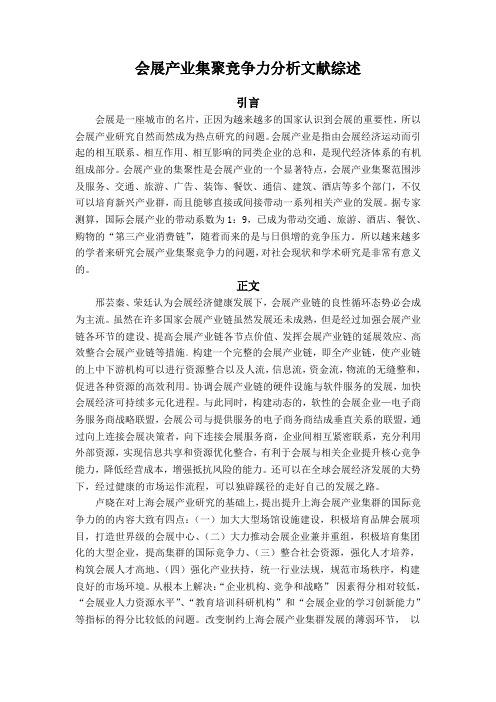
会展产业集聚竞争力分析文献综述引言会展是一座城市的名片,正因为越来越多的国家认识到会展的重要性,所以会展产业研究自然而然成为热点研究的问题。
会展产业是指由会展经济运动而引起的相互联系、相互作用、相互影响的同类企业的总和,是现代经济体系的有机组成部分。
会展产业的集聚性是会展产业的一个显著特点,会展产业集聚范围涉及服务、交通、旅游、广告、装饰、餐饮、通信、建筑、酒店等多个部门,不仅可以培育新兴产业群,而且能够直接或间接带动一系列相关产业的发展。
据专家测算,国际会展产业的带动系数为1:9,已成为带动交通、旅游、酒店、餐饮、购物的“第三产业消费链”,随着而来的是与日俱增的竞争压力。
所以越来越多的学者来研究会展产业集聚竞争力的问题,对社会现状和学术研究是非常有意义的。
正文邢芸秦、荣廷认为会展经济健康发展下,会展产业链的良性循环态势必会成为主流。
虽然在许多国家会展产业链虽然发展还未成熟,但是经过加强会展产业链各环节的建设、提高会展产业链各节点价值、发挥会展产业链的延展效应、高效整合会展产业链等措施。
构建一个完整的会展产业链,即全产业链,使产业链的上中下游机构可以进行资源整合以及人流,信息流,资金流,物流的无缝整和,促进各种资源的高效利用。
协调会展产业链的硬件设施与软件服务的发展,加快会展经济可持续多元化进程。
与此同时,构建动态的,软性的会展企业—电子商务服务商战略联盟,会展公司与提供服务的电子商务商结成垂直关系的联盟,通过向上连接会展决策者,向下连接会展服务商,企业间相互紧密联系,充分利用外部资源,实现信息共享和资源优化整合,有利于会展与相关企业提升核心竞争能力,降低经营成本,增强抵抗风险的能力。
还可以在全球会展经济发展的大势下,经过健康的市场运作流程,可以独辟蹊径的走好自己的发展之路。
卢晓在对上海会展产业研究的基础上,提出提升上海会展产业集群的国际竞争力的的内容大致有四点:(一)加大大型场馆设施建设,积极培育品牌会展项目,打造世界级的会展中心、(二)大力推动会展企业兼并重组,积极培育集团化的大型企业,提高集群的国际竞争力、(三)整合社会资源,强化人才培养,构筑会展人才高地、(四)强化产业扶持,统一行业法规,规范市场秩序,构建良好的市场环境。
《展馆运营管理与营销策略研究国内外文献综述2400字》
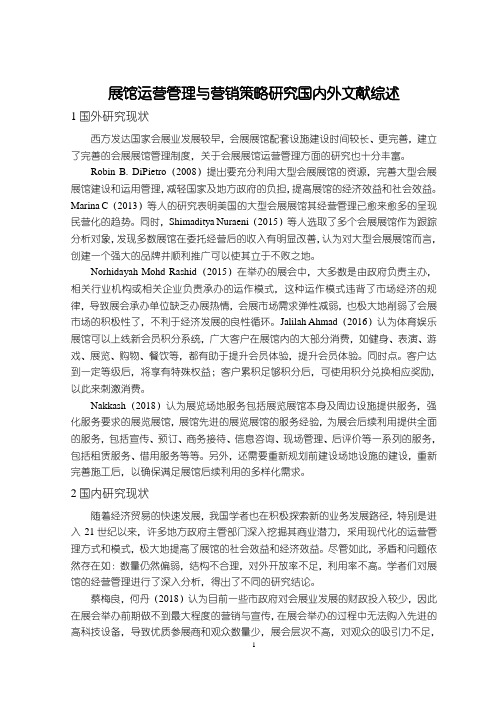
展馆运营管理与营销策略研究国内外文献综述1国外研究现状西方发达国家会展业发展较早,会展展馆配套设施建设时间较长、更完善,建立了完善的会展展馆管理制度,关于会展展馆运营管理方面的研究也十分丰富。
Robin B. DiPietro(2008)提出要充分利用大型会展展馆的资源,完善大型会展展馆建设和运用管理,减轻国家及地方政府的负担,提高展馆的经济效益和社会效益。
Marina C(2013)等人的研究表明美国的大型会展展馆其经营管理已愈来愈多的呈现民营化的趋势。
同时,Shimaditya Nuraeni(2015)等人选取了多个会展展馆作为跟踪分析对象,发现多数展馆在委托经营后的收入有明显改善,认为对大型会展展馆而言,创建一个强大的品牌并顺利推广可以使其立于不败之地。
Norhidayah Mohd Rashid(2015)在举办的展会中,大多数是由政府负责主办,相关行业机构或相关企业负责承办的运作模式,这种运作模式违背了市场经济的规律,导致展会承办单位缺乏办展热情,会展市场需求弹性减弱,也极大地削弱了会展市场的积极性了,不利于经济发展的良性循环。
Jalilah Ahmad(2016)认为体育娱乐展馆可以上线新会员积分系统,广大客户在展馆内的大部分消费,如健身、表演、游戏、展览、购物、餐饮等,都有助于提升会员体验,提升会员体验。
同时点。
客户达到一定等级后,将享有特殊权益;客户累积足够积分后,可使用积分兑换相应奖励,以此来刺激消费。
Nakkash(2018)认为展览场地服务包括展览展馆本身及周边设施提供服务,强化服务要求的展览展馆,展馆先进的展览展馆的服务经验,为展会后续利用提供全面的服务,包括宣传、预订、商务接待、信息咨询、现场管理、后评价等一系列的服务,包括租赁服务、借用服务等等。
另外,还需要重新规划前建设场地设施的建设,重新完善施工后,以确保满足展馆后续利用的多样化需求。
2国内研究现状随着经济贸易的快速发展,我国学者也在积极探索新的业务发展路径,特别是进入21世纪以来,许多地方政府主管部门深入挖掘其商业潜力,采用现代化的运营管理方式和模式,极大地提高了展馆的社会效益和经济效益。
展会经济发展设计参考文献
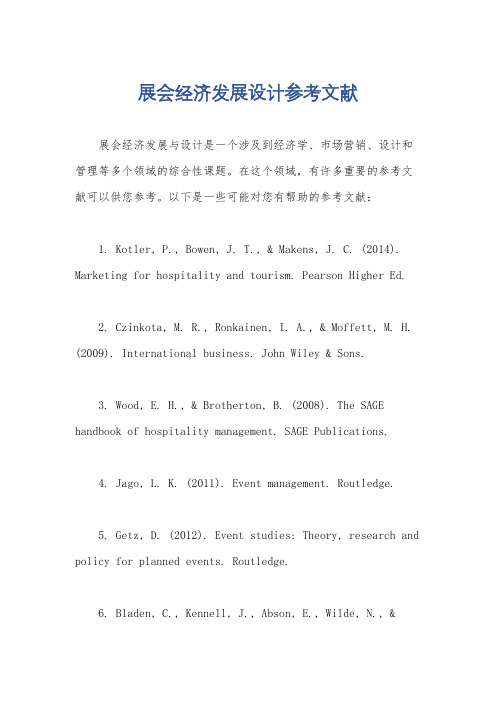
展会经济发展设计参考文献展会经济发展与设计是一个涉及到经济学、市场营销、设计和管理等多个领域的综合性课题。
在这个领域,有许多重要的参考文献可以供您参考。
以下是一些可能对您有帮助的参考文献:1. Kotler, P., Bowen, J. T., & Makens, J. C. (2014). Marketing for hospitality and tourism. Pearson Higher Ed.2. Czinkota, M. R., Ronkainen, I. A., & Moffett, M. H. (2009). International business. John Wiley & Sons.3. Wood, E. H., & Brotherton, B. (2008). The SAGE handbook of hospitality management. SAGE Publications.4. Jago, L. K. (2011). Event management. Routledge.5. Getz, D. (2012). Event studies: Theory, research and policy for planned events. Routledge.6. Bladen, C., Kennell, J., Abson, E., Wilde, N., &Reed, M. (2017). Events management: An introduction. Routledge.7. Allen, J., O'Toole, W., Harris, R., & McDonnell, I. (2011). Festival and special event management. John Wiley & Sons.8. Masterman, G., & Wood, E. H. (2006). Innovative marketing communications: Strategies for the events industry. Butterworth-Heinemann.这些参考文献涵盖了市场营销、国际商务、酒店管理、活动管理等相关领域的重要著作,对于展会经济发展与设计的研究和实践都具有一定的指导意义。
- 1、下载文档前请自行甄别文档内容的完整性,平台不提供额外的编辑、内容补充、找答案等附加服务。
- 2、"仅部分预览"的文档,不可在线预览部分如存在完整性等问题,可反馈申请退款(可完整预览的文档不适用该条件!)。
- 3、如文档侵犯您的权益,请联系客服反馈,我们会尽快为您处理(人工客服工作时间:9:00-18:30)。
关于我国(重庆)会展经济发展问题——文献综述重庆工商大学贸易经济专业05级贸经二班崔颖指导教师:杨军摘要:进入90年代以后,特别是“九五”以来,我国经济生活中出现了一种新的经济现象,即在全国各地,尤其是在一些大中城市,各种类型的国际国内技术交流会、商品交易会、信息发布会、经济研讨会等会议逐年增加,多种集商品展示、交易和经济技术合作等功能为一体,并具备信息咨询、投资融资和商务服务等配套功能在内的综合性展览展销和经济博览等形式也纷纷出现,其数量和规模不断扩大,并显示出强劲的发展势头,已经构成了初具规模的会展经济。
会展经济对我国经济生活的多个方面开始产生重要的影响。
作为一种新的经济现象和经济发展的新增长点,会展经济已经引起了社会的重视和关注。
面对这种情况,认真研究会展经济的内涵、功能和作用,分析存在的主要问题,提出规范发展我国会展经济的政策建议,众多专家学者纷纷撰文研究。
本文将对一些学者的有关研究观点进行综述分析。
关键词:会展会展经济功能现状启示Abstract: Into the 90s, especially the "Ninth Five-Year Plan", China's economic life there is a new phenomenon, that is all over the country, especially in some large and medium-sized cities, various types of domestic and international technology exchange, commodities Fair, conference information, such as economic seminar session has increased year by year, multi-commodity display, trade and economic and technical cooperation functions, with information and advice, investment financing and business support services, features a comprehensive exhibition Expo exhibition and also in the form, and their number is continuously increasing, and showed strong momentum of development has constituted the shape of the exhibition economy. Exhibition on China's economy in many areas of economic life began to have a major impact. As a new economic phenomena and economic development of a new growth point, the exhibition economy has aroused the attention and concern. Faced with this situation, serious study of the Convention and Exhibition economic connotation, function and role of the analysis of the main problems and put forward the development of norms and Exhibition of China's economic policy proposals, many experts and scholars study author. This article will have a number of scholars point of view of the study were reviewed analysisKey Words: exhibition exhibition economic Inspiration会展业是一种新兴的服务行业,在国际上有1:9的说法,即如果会展项目的收入为1元钱,则带动关联产业的收入就达到9元钱,其影响面广,关联度高,属于高附加值服务业。
目前,会展经济越来越受到各地的重视,展馆面积不断扩大,展览项目也不断增多,在北京、上海、广东地区已经形成中国的三大会展产业中心,而在中国的西部和中部地区,也兴起了西安、昆明、重庆、成都、长沙等重要会展城市,并逐步发展成为地区新的经济增长点。
近年来,随着会展业的发展,对我国会展经济领域的研究工作也得到逐步加强,主要的会展经济研究机构包括商务部所属中国会展经济研究会、社科院所属北京国际城市发展研究院会展经济研究所、广州大学会展经济研究中心、上海交大会展经济研究中心等等。
各个相关行业也不断涌现出对于会展、会展产业和会展经济领域的研究和论述。
一、会展业、会展经济的涵义、作用与功能1、会展业的涵义会展业是国际新兴业态,被喻为“城市的面包”、“市场的风向标”等等,在国际上发展速度很快。
十九世纪八十年代,这一概念传入国内,在国内引起各个城市的广泛关注,并迅速发展。
有关会展业的定义,有狭义和广义之分,业内有关会展理论和实务方面的专家学者在这方面的意见并不统一,主要的观点包括:云南大学工商管理与旅游管理学院的李云霞副教授在《会展业与会展旅游市场开发》【1】一文中认为:会展业作为当今世界范围内发展迅猛的新兴行业,是集商务活动、会议展示、观光旅游、对外宣传“四位一体”的新兴产业,有力地推动着各国旅游业和整个经济的发展。
经济发达、风光宜人、交通便利的城市都非常重视拓展其会展功能,从而带动区内相关行业的大力发展。
而对于这一概念,广东商学院旅游与环境学院的张伟强则在其《略论产业集群与会展经济的耦合与非耦合关系效应》【2】中有所提到,他认为会展业是指由会展经济运动而引起的相互联系、相互作用、相互影响的同类企业的总和,是现代经济体系的有机组成部分。
辽宁省知识产权局的胡嘉禄在其所著的《关于做强我省会展业的思考和建议》【3】对此概念解释到:所谓会展业,它是指在较短的时间4里,在相对集中的空间里,用较少的成本做成最大生意的交易行为。
国家外汇管理局上海分局外汇管理处的陈小五认为:会展业是指提供会议和展览综合服务的产业,主要包括在一国境内举办的国际性会议和国际性展览会。
在其《会展业发展及其外汇管理对策分析》【4】中有所说明。
济南大学旅游学院的梅青、张志全则在其《论山东省会展业发展的机遇与挑战》【5】中对此概念进行阐述,他认为会展业是指通过举办各种形式的会议、博览会、展览会而获取经济效益的一种行业,其产品在国际上统称为“MICE”,即:Meeting、Incentive、Convention and Exhibition。
小结:尽管会展作为一种市场行为早就存在,但是由于会展业作为一种行业,还是种新兴业态,因此不仅在国内,就是在国际上也没有一个统一的定义,但是,不论是狭义的定义还是广义的定义,各个专家学者对于会展业应隶属于高附加值服务业的认识是比较统一的。
2、会展经济的涵义会展经济在我国通常被译为:Conference and exhibition economy,但是在国际上,却没有这样一个专有词汇,在行业划分方面,通常也把会议和展览划分为不同的领域。
在我国,随着各种会议和展览项目的不断增多,产生了会展经济这样一个专有词汇,并对社会生活产生了多个方面的重要影响,然而对于会展经济的涵义。
很多专家也有不同的理解:湖北省工商局的李正人在其发表的文章《会展业应在规范管理上下功夫》【6】中指出:会展经济是指在国际大都市或基础设施完善、成熟的旅游地,通过举办各种形式的会议和展览展销,以达到获得直接或间接的经济和社会效益,提升地区形象的一种经济行为。
中国食品工业记者刘怡在《会展经济三人谈(之二):中国需要会展业会展业需要中国——中国贸促会轻工分会王本和副会长一席谈》【7】中提出:所谓会展经济,就是指举办各种会议、展览会获得直接或间接的经济效益和社会效益的经济活动。
烟台大学经管学院孙志毅《烟台会展经济的现状分析及前景展望》【8】一文中提到说:会展,即会议和展览的简称。
所谓会展经济,则是指通过举办各种形式的会议和展览带动相关产业的发展,促进社会财富增长的经济活动的总称。
华东师范大学西欧所的甄明霞、欧阳斌在其联合著文中《会展经济——城市经济的助推器》【9】提到:会展经济是指通过举办大型会议和展览带动相关产业发展,促进财富增长的各种经济活动的总称。
河南省洛阳市财政学校的刘宗太在《我国会展经济发展存在的问题及对策》【10】中介绍到:所谓会展经济,是指举办会议、商品展示、展览等活动的一种经济形式。
小结:会展经济作为现今社会经济的新的增长点,已经被越来越多的人所认知和接受,虽然各位专家对会展经济的概念有不同的说法,但是会展经济通过会议、展览等活动给社会带来的经济利益是不容小视的。
3、会展(经济)的作用如果仅从经济核算的规模上看,即使将其连带效应算进去,中国的展览业也不过上千亿元人民币的产值,还不到全国GDP的1%。
但是,正如吴仪副总理所说,展览业有着“它的独特作用”。
深圳南油集团的翟健栋曾经在其所发表的《构建深圳会展经济新框架》【11】一文中提到:会展业是一门综合性、带动性强的新兴产业。
在市场经济条件下,会展活动能汇聚巨大的信息流、技术流、商品流、人才流和资金流。
据专业机构测算,会展业的产业带动系数大约为1:9。
其主要作用表现在:(1)创造直接经济效益。
(2)促进经济贸易合作。
(3)带动相关产业发展。
(4)增加大量就业机会。
(5)传播交流知识信息。
湖北商业高等专科学校的陈向军曾经在《大力发展会展经济培育新的经济增长点》【12】中讨论过会展经济的作用问题,他认为:(1)会展能够创造经济效益(2)会展促进了信息交流、技术移动及商品流通(3)会展能够展示一个国家或地区物质文明和精神文明建设成果(4)会展为企业展示企业理念、宣传企业形象、扩大品牌影响提供了舞台(5)会展能够带动相关产业的发展(6)会展能够增加社会就业中国会展经济研究会副会长陈泽炎在《重视会展的独特作用》【13】中关于会展经济的作用提到:首先,中国展览业是一新兴的产业和行业,属于应当发展的第三产业(服务贸易)的范畴。
